
Have you been taught that you must use whey or another culture starter when making beet kvass? (You don't.)
Are you dairy free, on a tight budget, on the GAPS or SCD diet and therefore cannot buy and use whey or other culture starters? (Don't worry!)
Have you been taught that if you do not use a culture starter to make beet kvass, it must contain so much salt that it is not pleasurable to drink? (Not true.)
For these reasons or more, have you been living without the beauty of beet kvass in your life? These are all common misconceptions and I think it's time we all set them aside and empower ourselves to harness the transformative powers of mother-nature.
Beet Kvass is comprised of simple ingredients and is simple to make through the process of wild fermentation. Fancy fermentation equipment is fun, convenient, and pretty but rarely a must.
What is Beet Kvass?
Here in my kitchen, we call it blood of the earth. Indeed I do taste the earth when I sip this crimson liquid. Beet Kvass is an age-old tonic associated with many health benefits including efficient hydration. Fermented beverages are the original sports drinks. Like other lacto-fermented drinks, kvass is more hydrating than even water. In order to remain hydrated, our bodies require a balance of electrolytes. Cultured beverages like kvass help restore this balance without the sugar and preservatives of modern “sport drinks”.
Beet Kvass is traditionally heralded as a blood and liver tonic. And indeed this ancestral knowledge is meted out in science. In fact, beets are high in betacyanin which can dramatically increase the oxygen-carrying ability of the blood.
Personally, beet kvass gives me a feeling of energy and clarity. I LOVE beets and the taste of beet kvass. If you don't love the taste but do want the health benefits of this tonic, try adding it to a soup when serving or use it to make a virgin ‘dirty martini' or ‘bloody mary'. The taste is perfect for these concoctions and a big hit at any dinner party I've ever had.
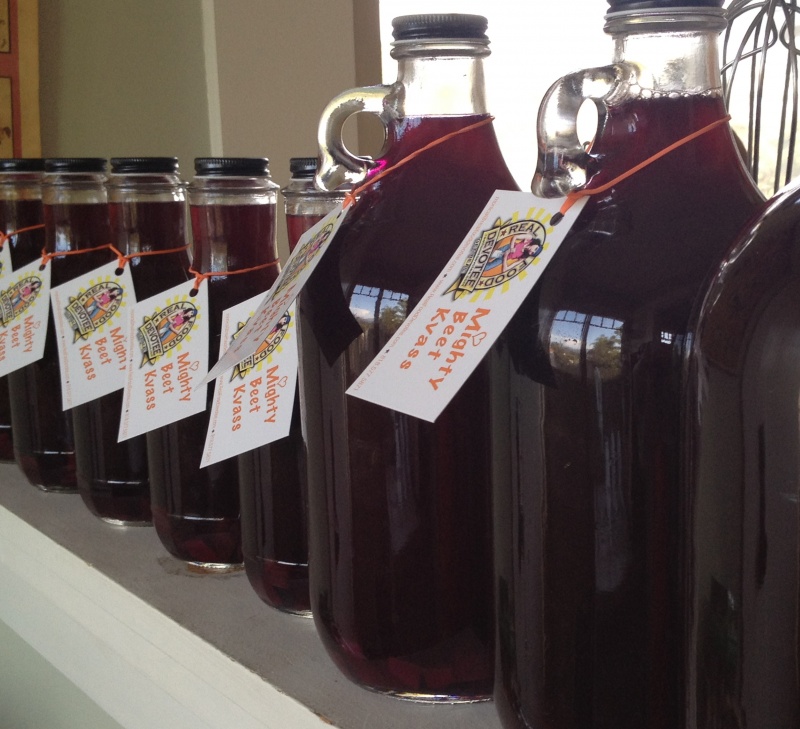
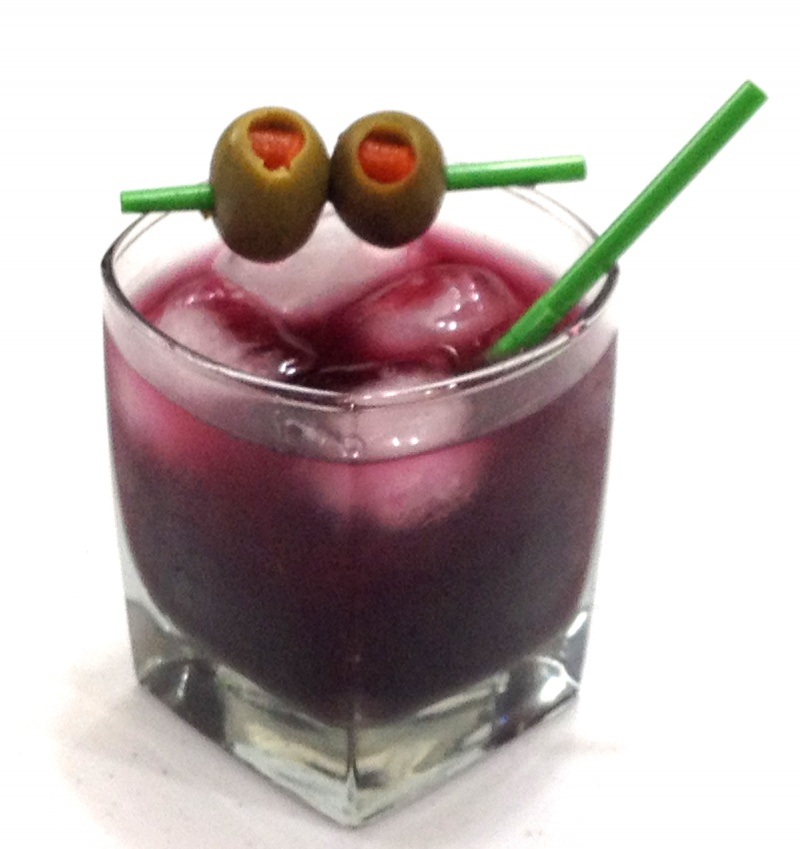
Beet Kvass Ingredients
- Filtered water
- 3-4 beets
- 1 ½ tablespoon unrefined sea salt
Beet Kvass Method
- Wash the beets of any dirt but, do not scrub or peel the beets. Our aim is to keep the delicate bacteria on the skin of the beets in tact so that we can encourage their multiplication during fermentation.
- Chop the beets. I like a medium dice.
- Add the beets to a 1-gallon jar.*
- Add 1 ½ tablespoon unrefined sea salt
- Add filtered water to ½ inch below lid
- Affix lid tightly and label with date.
- Allow to ferment for 1 ½ weeks or more out of direct sunlight.
- You may strain through a cheese-cloth and decant into smaller containers, taking care to redistribute a handful of beet pieces into each bottle and then store in the refrigerator. Or feel free to store in the refrigerator as is.
Chef Notes:
*If you have difficulty successfully using wild fermentation methods in your environment/home, consider using a jug with an airlock affixed to the top to ferment beet kvass. This will mitigate the introduction of funky yeasts from your environment making a film on top of your fermenting kvass.
 This post was generously contributed by Monica Ford of Real Food Devotee. Monica's recipes will make your mouth water and your tummy purr. If you're lucky enough to live in Los Angeles, Real Food Devotee can make your life easier by delivering nutrient dense goodies directly to your door.
This post was generously contributed by Monica Ford of Real Food Devotee. Monica's recipes will make your mouth water and your tummy purr. If you're lucky enough to live in Los Angeles, Real Food Devotee can make your life easier by delivering nutrient dense goodies directly to your door.
photo credit: An Eye Full Studio



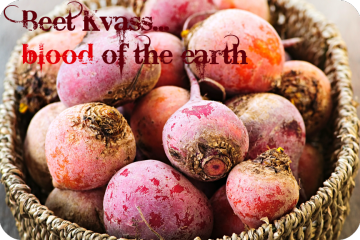

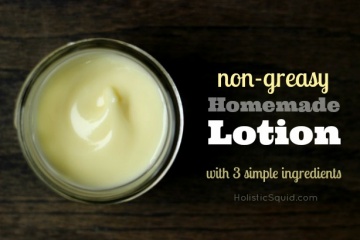



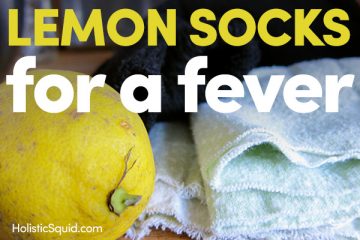
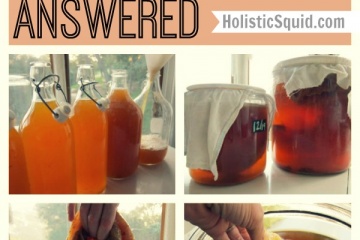
Won’t the tight lid break the jar when fermentation starts?
@Laura
The fermentation does never develop so much gas. It’s not like the wine making, where there is a lot of pressure.
What do you do with the beets after
You can chop them into cubes and put them in your salad. Or puree them with olive oil to make a salad dressing or a drizzle for goat cheese or feta. Or even throw them in with other vegetables for the last 10 minutes of roasting or sauteeing. Or put them through your juicer to maximize your kvass yield…
Like with second fermentation kombucha, I burp my beet kvass.. Enjoy
I’ll have to try this!
I made kvass with my garden beets and love it. I’ve started adding turmeric root to the recipe to get the anti-inflammatory benefits. I drink 4/6 ounces every morning.
Hi @Laura
I’ve never have an issue with a tight lid breaking during wild fermentation of beet kvass but, if you’re concerned about this, go with a plastic lid instead. The lid will not actually touch your ferment and will be more flexible than metal:)
I’m with you though I use more salt and let mine ferment longer. I love it thick and salty.
How long can you keep it in the refrigerator? How much should you drink and how often?
This question was not answered, and I have the same question. I have some kvass from about four months ago – no scum, clear and jarred in the fridge all this time. Can I still drink it safely?
If it smells and tastes ok it’s fine. Kvass keeps for a long time in the fridge.
Start out with a 1/4 cup twice a day. Work up to as much as you enjoy as long as you don’t have GI issues.
@Charity makes a great point. When making artisan, fermented foods, you can create to your own tastes. Magic!
@BB start with 4-6oz Beet Kvass in the morning. It is quite detoxifying so slowing work your way up to more if you like.
It can be kept in the frige for months:)
I have been dairy-free for months and was wondering how I coud try this. Thanks ever so much!
yaaay @Michelle
Let us know how yours turns out!
I’ve got a couple of jars at home of beet kvass that I made this summer. It was way too salty and I just couldn’t bring myself to drink it. I love beets but more on the sweet side instead of the salty side. I’ll have to try this, since I have some beets in the fidge now that are begging to be used.
Do you cut the beets before putting them in the gallon jar?
Yes. Cut into one to two inch cubes.
Hi @Amanda
Thanks for catching that. Yes indeed.
I do chop the beets into roughly 1 inch cubes
Hi @Saeriu
I sometimes make a sweet sparkling beet kvass. Maybe I will share that recipe in the future. xo
I would love to have your recipe for the sparkling beett kvass
I would love to know how you make this also. I also have a question about storage. You have a beautiful picture at the top of this post with lots of bottles. How can you possibly store all this in the fridge? I have a five gallon pail of beets to use up….I already made beet wine with one five gallon pail!!!
Please share. The sparkling beet kvass sounds interesting
I have been such a chicken about trying wild fermentation. You make it sounds so easy, and I’ve got beets coming out of my ears. Sounds like a good time to take the plunge. Thanks!
Go for it, “Little Sis”! Once you start fermenting, you won’t be able to stop. 😉
Thank you for your submission on Nourishing Treasures’ Make Your Own! Monday link-up.
Check back tomorrow when the new link-up is running to see if you were one of the top 3 featured posts! 🙂
I have health issues with my back and have pinched nerve in my neck and was getting head aches all the time and last fall I started using rejuvenate every day and my head aches disappeared . This is made by sprouting 1 1/2 cups of whole red wheat seeds to 1/4 inch tails and then adding 1 gallon of distilled water to it and letting it wild ferment for 2 days and then saving the juice off of it and doing it 2 more time with only 1 day in between . I will never give this up and I also do beet kvass and I do fresh pineapple the same way as the beet kvass . Last year my store started selling fresh whole raw milk and I do whey and cream cheese also . I also make my own sauerkraut and eat it raw . All of this I have learned on the internet and my over all health has greatly improved . If you take care of your stomach , your stomach will take care of you and this is also in the Bible ….. So try all these things …… michaelvangogh
I have health issues with my back and have pinched nerve in my neck and was getting head aches all the time and last fall I started using rejuvenate every day and my head aches disappeared . This is made by sprouting 1 1/2 cups of whole red wheat seeds to 1/4 inch tails and then adding 1 gallon of distilled water to it and letting it wild ferment for 2 days and then saving the juice off of it and doing it 2 more time with only 1 day in between . I will never give this up and I also do beet kvass and I do fresh pineapple kvass . Last year my store started selling fresh whole raw milk and I do whey and cream cheese also . I also make my own sauerkraut and eat it raw . All of this I have learned on the internet and my over all health has greatly improved . If you take care of your stomach , your stomach will take care of you and this is also in the Bible ….. So try all these things …… michaelvangogh
Is the 10 day ferment a hard and fast rule? I began my first batch of kvass one week ago today, and it’s very fizzy. Should I consider it to be ready or do I need to give it three more days? Thanks!
Hi @Melissa
No. 10 days is not a hard and fast rule. You may take your kvass off ferment now if you would like or you may go for a month or more.
I think you should take this batch off and begin to enjoy is earthy goodness! xo
The kvass turned out SO well!!!! It tastes delicious. I feel like I’m having a soda or something!
@Melissa how wonderful! I can’t help but be proud of u! Enjoy the delicious health benefits!
What do you do with the beets after the kvass is gone?
Hi @reluctant you COULD eat them but I find them a bit tasteless so they usually find a home in the compost:)
I’ve tried to make this using a Fido jar & Caldwell starter along with the salt. Organic beets. It got something filmy on the top, mold? Is there an optimal ferment temperature for beets? Any advice would be appreciated
Thanks for the recipe! I tried it out (because I had leftover beets with no plans) and I believe it turned out well. (Did half recipe, fermented 10 days, got a little foamy on top..) However…this is my first time even tasting it, and I can’t say I’m a huge fan of drinking it plain. I mixed a little with some of my fizzy coconut kefir and that helped the medicine go down 🙂 It made a fun, bright magenta color when the two mixed!
Try fermenting it for 28 days then let it sit in the fridge for a while. Should taste better than a 10 day ferment.
Hi! I just made some beet kvass and then I realized that I forgot to add salt! So it was just like soaking beet pieces in water for a day. Can i save it? What do you recommend?
Hi @Xandria
Open her up and add the salt. This isn’t ideal so please let us all know what happens:)
@Lynn
I feel another recipe post coming on
Hi everyone,
One question if I can?
First timer here, ok beet kvass is suppose to be a very beneficial drink and I agree with you, but there is one thing that I do not think is so good in this drink and that is the 1½ spoon of salt in it.
Is there a way to ferment the drink without the salt or using less of it? Thank you for your help, and congratulations for the site…
Hi @Jorge
Yes. Salt is needed if seek to create favorable conditions for lactic acid bacteria to ferment. If we were seeking to make an alcoholic fermentation, we would not need salt.
Salt is one step toward preventing moldy bacteria from growing in a ferment during the initial stage of fermentation where the oxygen is used up and the lactic acid bacteria begin to reproduce. Since fermentation always occurs in the same pattern no matter what we’re fermenting, we use salt to keep the bad guys at bay until the LABs kick in and start growing like crazy.
The correct salt concentration will encourage LABs to grow, giving them a competitive edge. Too little salt gives the icky bacteria an edge, which can lead to spoilage.
Also, high quality sea salt (not our modern day processed table salt) is mineral rich and trace minerals are sorely lacking in present day soil, water and foods.
So, drink up and enjoy! xo
Hello, I have made beet kvass a few times with different recipes. Sometimes it is fizzy and some times it just goes bad (and everything in between). I am using your recipe because we are casin free and there are tons of tiny white bubbles so I opened it up expecting it to fizz and it still tasted flat. Should I let it keep fermenting? I really like it fizzy 🙂 Thanks for all the advice in advance.
Hi @Angela
How long have you been fermenting the kvass?
If you’d like a sparkling kvass try straining and decanting you kvass into quart or smaller size bottles and add a little beet juice to the bottle (2 T/quart). Put the lid on snug and ferment for approx 24 hours (shorter time in warmer weather). It will become fizzy.
Enjoy!
Thank you! I will try that. I might also try adding 2 tbs of kombucha instead 🙂
@Angela
That will very likely work as well. Let us know!
Question: Do you chop the beets or just throw them whole in the jar? I always followed the Nourishing Traditions’s recipe that calls for chopped and peeled beets.
Hi @Drito
Thanks for catching that. Yes indeed.
I do chop the beets into roughly 1 inch cubes
What is the waxy film that sometimes develops on top of the beet kvass after its been fermenting for several days? is it still ok to drink if you remove this?
I made some beet kavass and it has been sitting in my frig for a several weeks now. When I check on it today it was a murky brown color at the top but the bottom of it was a deep purple. When I shook it everything blended together. Is this normal and is it still good?
Hi @Tye
It is totally normal for most of the pigment in beet kvass to fall to the bottom of the vessel when undistrubed for days, weeks, months. Just give her a shake or a stir and drink up. Why is it sitting in your fridge? Drink. Drink! xoxoxo
Janelle asks: “What is the waxy film that sometimes develops on top of the beet kvass after its been fermenting for several days? is it still ok to drink if you remove this?”
Hi @Janelle
Go ahead and scrape off this film. And then (this is optional) you can strain your beet kvass through a fine mesh strainer or a strainer lined with cheese cloth when you bottle just before storeing in the fridge. Enjoy!
I have kombucha, water kefir, milk kefir and beet kvass on the go. There is only so much room in the fridge and only one person drinking these drinks. Is there another way to store these liquids? With the kvass I found it too salty. After I’d consumed about 6 ounces I added another beet and topped it up with water. The foam that formed was skimmed off and now the kvass is yummy. This was made in a quart jar.
Hi @Joan
If you like, you can store your kombucha and beet kvass in a cool area of your home. Kvass was traditionally stored in root cellars.
What size was your original vessel of kvass? Also a quart? How much salt did you add to the original batch? Happy fermenting!
Can you save some of the kvass to use as a starter for more or as a starter for other fermented foods?
Hi @Jill
There are differing opinions out there on this. My opinion is that you not only do not need to do this, it is not effective as bacteria go through a life cycle during fermentation.
Is there such a thing as drinking too much beet kvass, beyond having a detox effect?
Hi @Jo B
As with any food, it’s very unlikely you’ll OD on it but, moderation is a good policy. So as long as the majority of your diet is not made up of beet kvass and beyond die-off or detox discomfort beet kvass there is no evidense of ill effects from beet kvass.
Go slow when you start. 4-6oz in the morning is a great starting point.
And drink in moderation there after. Listen to your body.
The point of consumer probiotic foods is to consumer a varitety which builds stronger immunity through diverse probiotic strains. Enjoy!
My 2nd batch got a blue moldy film on top. It smells fine and looks fine after I skimmed it off. Do you think it is safe to drink?
Yes
I’m glad you’re making kvass @Blondie
My official advice to you is to toss the batch. However, much of the traditional wisdom on this is to scape off the mold and drink up.
I have a few beets from CSA. The only jar I have is a glass one with metal lid that I use for my kombucha. Can I use this jar? Can I use water from reverse osmosis?
@tracy
Yes indeed. Do it! Xo
I just tried this out and after 2.5 days one of my beet jars is bubbling over and smells amazing and the other one has a couple bubbles here and there and smells very earthy, very beet-y. Does the second one just need more time? Is the first one ready to drink or should I hold off for the full 10 days?
I let my kvass sit for about 2 weeks without looking at it and went to strain and pour it into other jars! YIKES! Ther was a putrid smelly mold on top and down the disposal it went!! What went wrong?? I followed your directions explicitly! This is the second time I have tried and failed! Please advse!
Thanks for your comment @Christeena
If you have difficulty successfully using wild fermentation methods in your environment/home, consider using a jug with an airlock affixed to the top to ferment beet kvass. This will mitigate the introduction of funky yeasts from your environment making a film on top of your fermenting kvass.
I’ve been making and enjoying beet kvass for the last couple of months, but my most recent batch tastes musty. I don’t want to drink something that may be harmful – that defeats the purpose of drinking kvass in the first place! I use a large jar, 2 gal, and it doesn’t have an airtight lid. I clean it well before each use, and keep it covered with wax paper, a thin spongy placemat and a heavy book for the 3-4 days it takes to get dark in color. Occasionally I get a little white fur floating on top, which I spoon out before straining the kvass into smaller jars. Any idea what would give it the musty, almost moldy flavor? And is it ok to drink, or should I toss it and start a new batch?
Thanks!
My beets are really small. Should I half the recipe? Can I use the same size jar and less ingredients?
Also, what about adding things like carrots, ginger, cabbage, cinnamon?
OMG! as someone who grew up drinking real Kvass in Russia in the 70s this is SO NOT KVASS! This is closer to Korean fermented drinks… for the love of god stop calling this Kvass!
@RussianGuy, what is real beet kvass? You’ve made me curious. Do you like it?
There are different kinds of kvass!! Russian kvass is more of an alcoholic beverage and made differently. This recipe is your standard Ukrainian style kvass used in recipes such as borscht.
@RussianGuy Учите матчасть. This is real beet kvass. Bread kvass is the most popular one, yet there used to be dozens of types of kvass: vegetable, berry, fruit, honey kvass. You’ll find it in домострой, Молоховец, any pre-revolution time period cookbook.
Hi @Kristine
That musty taste is a little yeast contamination. It is very likely fine to consume but, will not be delicious. A well-fitting lid would be a good fix for avoiding the ocational yeast contamination or a lid with airlock like this http://tinyurl.com/k3wfott
Happy fermenting!
Hi,
I wanted to comment in reply to those saying their kvass smells musty or mouldy. I’ve had this happen. I have stopped buying beets in a bag. They are not fresh and have a mouldy smell right from the start. If you buy beets with green tops, you might find your problem goes away. It worked for me!
Hello I have used the airlock. But I am still getting mold. What am I doing wrong? My kvass does not become fizzy. I use beets sea salt and let it ferment for two weeks. Any advice?
Hi Diana, if you are using a clean container & airlock and the ratios of salt, water, and organic beets listed in the recipe, I would suggest you should experiment with adding ½ head of organic cabbage (rough chop). If you still have mold (not a little sludge rising to the top which can be dirt residue from the beet outer peel), use a starter. Rarely our micro environment contains too many mold spores to make this successful. ~ Monica
Take the mold off and drink the Kvass it should taste like pickled beet juice when mine molds it has the best taste
Hi @Jill
Yes. YOu can use fewer ingredients in a larger contianer but, you must still fill the container with water as in the instructions above. YOur batch will be a bit more diluted but if you don’t mind, neither will the kvass.
Yes. YOu can add carrots, ginger or cabbage.
You may add cinnamon if you like but, only in whole stick form. Not ground cinnamon.
xo
I let mine ferment for almost 4 weeks. It is WAY too salty! Does it have any of the LABs in it if it is too salty or did that totally nullify the LABs cycle? If no LABs, I will toss it… but if it has any health benefits, I will add filtered water and drink it. Thanks for your help!
I only use 2 teaspoons sea salt in a gallon
Hi Monica! I just tried my third attempt with this recipe and finally got it right (I think I was storing it too close to other ferments before, but found a new spot which seemed to help). Yeehaw!
I have a couple of questions:
1) does time make it saltier? Or does more salt make it saltier? I added the amount you listed above, waited two weeks and it’s tangy and not very salty. I remember yours being a little saltier (I loved it!) and you said you liked to wait longer, more like a month. Does more time remove some of the sharpness (tang)?
2) Now that I’ve opened it to taste it, do I have to bottle it? Or can I leave it to ferment a little longer?
Thank you!!
Thank you for a dairy-free recipe! I’ve got my first batch brewing (it’s been about 5 days) and I opened it up to scrape off the abundance of foam on top and to give it a taste. It smells and tastes cheesey, it’s not bad, it actually tastes good, but I’d like to know if this is unusual and if it’s safe to drink. Any advice would be appreciated!
hi @Suzanne
Thanks for your question and for adding more probiotics to the world.
Yes. The previeling traditional wisdom on this is that the kvass is still good to drink. Just skim (strain through fine mesh strainer if you like) and enjoy!
**If you have difficulty successfully using wild fermentation methods in your environment/home, consider using a jug with an airlock affixed to the top to ferment beet kvass. This will mitigate the introduction of funky yeasts from your environment making a film on top of your fermenting kvass.
Do I put the stem and root and everything in?
Also, why filtered water?
Hi @Lynn
Thanks for your question! I’m happy to see you’re fermenting. You definitely chop up and use the beet root and if you like, you can also chop up the stem and use it. No leaves tho:)
Yes! Higher probability of success when we use water sans chlorine
Thank you 🙂
So I checked in on my kvass. I had the regular white scum on top, but I also had beets of fuzzy white with a green middle bits of mold. I scooped that out with a spoon, I can still see small bits floating. Is it salvageable?
by beets I meant bits!
Hi @Joanna
Yes. You may keep a fermented tonic in your fridge and drink for months or years as it matures just like a sauerkraut. The taste will become deeper and more sour. Obviously if it were contaminated by mold you would throw it out just like any other food. Glad to hear you’re fermenting and Thank you for your question!
I just started making Beet Kvass. I’ve made a couple batches, letting it ferment for 2 days in a relatively warm house (70 degrees). I fill the quart jar half way with chopped beets, add 1/4 cup whey and 1 Tbsp salt, and then top it off with filtered water. The first day I can see a few bubbles come to the surface, and the second day a few more (but it never goes crazy like my water kefir). On the second day a little mold usually starts to form, so I skim that off and then I strain the kvass and put it in the refrigerator. It’s never been fizzy at all. It just tastes like salty beet water. Is it possible that it didn’t ferment? Does it need to be fizzy for it to be probiotic?
Hi @Jessica
Thank you for your questions.
firstly, you do not need quite so much salt in a quart size jar.
Yes, your kvass is fermenting. Though that is quite a quick fermentation time. The longer the fermentation time on beet kvass, the more the flavors mellow and marry. I love a long ferement kvass.
No, it does not have to be fizzy to be probiotic.
Why don’t you give the recepe above a try. I think you might be a little happier with the results. Enjoy!
Thank you for your response. I will try your recipe next, but I guess the one question that remains is — what about the mold that forms after 2 days at 70 degrees in our house. I do not cut the beets small; they’re rather large chunks. Should I just scrape the mold off 2-3x per day and continue on to a long ferment, or?… what would you do about the mold?
Hi Jessica,
Allow your kvass (with the recipe you described above) to ferment for 5-7 days. Skim at the end of the fermentation time and store in fridge. You can go one step further after skimming if you like and pour the kvass through a fine mesh sieve or cheese cloth, add the the beets back and store in the fridge. enjoy!
Can a person use himalayan salt instead of the unrefined sea salt?
Yes.
During the winter when the weather is colder, how you do keep the beet kvass warm enough? A heating pad?
The 1 ½ tablespoons salt you use appears to make a brine of .9%. Most kvass recipes Ive seen say to use 1.5% to 2% brine. Have you found that using this smaller amount of salt works better for you?
Hi @David
You can use a heating pad if you like. I do find that beet kvass will still ferment though at a slower pace in the colder months so, I just ferment for longer. In face, I tend to really enjoy a longer ferment on the kvass. I’ve tasted it up to a year on ferment and it only becomes more subtle, rounder and layered in its taste.
As for salt, I prefer the taste of 1 1/2 T salt per gallon kvass. I also, find that it works well in terms of fermentation success.
Thank you for your questions and happy fermenting!
Your ratio of salt to purified water is the bomb. 6 months trying various amounts with and without whey recipies this is perfect. I put a clove of garlic and 2 sprigs of dill per quart and am perfectly content with the taste. Next I will conquer Kombucha.
That’s so wonderful to hear @John
Happy Fermenting!
xo
Monica
I have bottled Kvass dated 62012 i found in basement. I guess i just made too much then.
Is there anyway it could make me sick if i drink? i have not yet opened it.
Thanks much,
I wondered if I could just use the beet stems to make kvass.
No, beet kvass requires beets.
Hi @Jan
David is right, if you used only beet stems to make kvass, it would be quite weak. However, you can certainly add them in to your beet mixture for kvass (no greens:). Or you can use them to make a cabbage tonic. Same recipe as beet kvass but, in stead of beets you might use chopped beet stems, shredded cabbage and a little giner. A delicious kvass and makes for a happy tummy.
For me, I love the chop the stems and cook them in bacon fat and a splash of apple cider vinegar. I cook them for a few minutes before adding the beet greens. Delicious! Let us know what you decide to do. xoxo
Hi, I followed your recipe meticulously, after 10 days I tasted it, and the taste was bad, it had a sour and vinegar type of taste, any ideas of what I might be doing wrong?
Lactic acid from lacto fermentation tastes sour and a bit like vinegar. It is supposed to taste that way.
You have blown my mind. I used to make beet kvass two years ago and enjoyed it, but since then I’ve ended up with old yucky beets in my refrigerator because I can never bring myself to &*(!# peel the beets anymore. Now that I know I don’t have to, I’m ready to make some beet kvass today!! And I have a sharp awesome knife now, so it’s even better!
my husband keeps telling me there are no calories in beet Kavas. I’m skeptical since beets are high in sugar – he says the fermenting eliminates the sugars. Help!
@Preston
I sounds like there is a little funky yeast creeping in. This could be because there was not enough bacteria present on the beets. This can happen if the beets are peeled, scrubbed, washed in chlorinated water, are not organic and have been exposed to strong pesticides. If non of these are the case, just remember that we each live in our own micro-environment.
If you have difficulty successfully using wild fermentation methods in your environment/home, consider using a jug with an airlock affixed to the top to ferment beet kvass. This will mitigate the introduction of funky yeasts from your environment making a film on top of your fermenting kvass.
Happy Fermenting!
@Angela
Awesome. I’m happy to help unleash the fearless fermenter in you!
Hi @Deborah
You’re husband is right that during fermentation, bacteria convert sugars into vitamins more probiotics and organic acids. The brand of kvass currently on the market, called Zukay sells a 12oz bottle of beet kvass with 60 calories, 1 gram of protein, and 7 carbs. Enjoy!
Hi, this sounds like a good recipe and I would look to try it, but how much are 3 beets? I have all sorts of sizes in my garden, from golf ball size to 3 or 4 times as large? Would anyone have a vague idea of the weight?
Thanks.
I had the same question… weight of beets per gallon would help a lot…
First timer here as well as a kvass maker. I’m going on 10 days today and in the beginning there were some tiny bubbles up top…now nothing. I opened it to check the taste and it’s quite salty. Having nothing to compare this to as it being my first time, am I too assume this is normal and may need to ferment longer? No sign of mold, funky smell, or other issues, just a salty beet taste and a strong beet smell. Normal? I’m using a mason jar, an organic beet, pink salt, filtered water, and some whey I collected by straining organic yogurt. Is there anything else I should be doing or is it just a matter of it needing to sit longer? Is whey good for kvass because I noticed your recipe doesn’t call for it? Thank you for any help.
I should have also included that some beets have floated to the top. Does that mean anything? I also know you can make a second batch with a little of the remaining first batch, but should I shake the jar before pouring the majority of the first batch or leave the sediment on the bottom for the next? So many questions when you’re a newbie. Glad there are helpful people like yourself to guide us. Thank you.
Just wanted to pop in & thank you for this recipe!
I’ve already made it once & I’m getting ready to make
another batch! It is so quenching, like an electrolyte drink,
but without the added dyes, artificial flavors and
weird chemicals. My body craves it!
I also wanted to mention to anyone going by the
Nourishing Tradition guidelines that this recipe
is SO much better. And because of the significantly
longer ferment than the NT recipe calls for, you can’t
really get a good second batch out of this recipe with the
beets. But it makes more than the NT recipe so it really
evens out, quantitatively. This one is MUCH better
qualitatively, however. I’ll never go back to the recipes
that use whey and short ferments!
Thanks again for the recipe, Emily! 🙂
I am keen to try this, but finding it hard to find a suitable gallon size jar. I am in Australia. Does it have to be made in a gallon size jar? I have found half gallon (2 liters) or 10 liters (obviously more than a gallon!)
Hi Karen, I am in WA and I tried this, 3 weeks on and its still fermenting. I tried some but it didn’t taste fermented, but just earthy and salty so I put it back to ferment longer. I put mine in a 5 litre jar and did the same ratio as recipe above. I just bought jars that sealed from Ikea. Let me know how yours go!
Hi! I made this recipe dairy free, and I didn’t have any fuzz, just a little white in one jar, after 6 days. Is that long enough?
It is salty, and I already refrigerated it, so do I need to strain it if I don’t see any foam or fuzz?
Thanks!
I am about to try this but was wondering if it’s ok to make it a sweet drink (adding stevia) instead of a salty one. I am not much for salty beets but rather have it sweetened. Would it still have the effects if I added stevia after pouring a cup?
Oh, I have another questions….. Instead of using stevia, or in addition to, can you mix the beets with some fruit, like berries? I was wondering if it would still have the same benefits. Thanks!
My NTP & I made this but added a few chunks of orange & ginger… she hates beets! But mine now has a white substance floating across the top & the liquid looks oily… it’s been fermenting in a quart jar for 10 days. I’m nervous to try it due to this white stuff which looks like mold. Even if i strain it, I wouldn’t be able to get the white stuff off the beets & orange chunks as it pours thru. Is it safe to drink?
If I make a smaller amount in an airlock jar, do I just half or quarter everything? Or do I just use less water and keep the other amounts the same?
Really?
I have been making successful beet fermentations with peeled beets because there is no need for dirt in a ferment. You are not fermenting dirt, you are fermenting the organisms that are part of the produce. Any process that does not use an airlocked anearobic vessel is unscientific and unsafe.
I use an air lock to reduce the chances of getting mold and yeast, but neither one is really dangerous if you use enough sea salt brine and keep the beets below the brine. I mainly do it because I like the taste better when there are no molds or yeasts growing on top. As far it being unsafe to not use an air lock. No it is not unsafe. Lots of people do all sorts of fermenting with just a cloth covering the fermenting jar to keep fruit flies out of it and it is perfectly safe (for example: kombucha and kefir and back in the olden days sauerkraut). The brine is what keeps it safe, and the lactic acid produced by the lacto bacteria keeps it safe. In reality, making it anaerobic could potentially lead to botulism if there wasn’t enough salt in the brine to prevent those types of bacteria from growing. Botulism only occurs in anaerobic conditions where there is not enough salt and where the weak brine is not acidic. Salt and acid are what prevent botulism.
In Nourishing Traditions the Beet Kvass recipe says 2 days at room temperture. Why is there a big difference in the fermenting time?
Delicious! I couldn’t wait so it wasn’t fermented the whole amount of time suggested in this recipe. I added a garlic cloves as I found out some people do. Made with all organic ingredients but with city water! I will use this recipe again. I find drinking some gives me energy.
hello,
I have just read a recipe at another website where they use only 1 to 2 tsp of salt per gallon. I am confused now!
Thank you
I used this method to make my first kvass. The only exception being I used a farmcurious lid. I feemented it for 4 weeks. Upon opening there was a some green spots on the lid and the glass where the liquid did not touch. The kvass tastes ok and didn’t have a bad smell. I’m assuming this was mold. If it was is that normal and or a problem? What do you recommend?
My friend just gave me a quart of kvass because I was feeling so run down. ( She made it) I’ve taken it three times on an empty stomach and I really feel less tired. Thanks for the recipe I’m going to start making my own.
I use a starter when I ferment beets because they have so much sugar I want to drive the fermentation in the right direction right from the start. I buy a jar of refrigerated beet kvass at the local health food store, and use 1/4 cup of it as the starter. Then I fill up the rest of it with the sea salt brine and beets. It works great every time. The store bought beet kvass is already full of the right bacteria that were previously feeding on beets, and they quickly wake up and start feeding on the new beets. I also use it as a starter for fermented shredded beets. I like this even better, because I eat the entire beet, not just the juice. I use a box shredder (the kind people use for making hashbrowns) and I shred the beets finely, and then stuff them down into the bottom of the mason jar. I then add the starter beet kvass and then add the sea salt brine. Then I put on the air lock and let it ferment for about a week and then put it in the refrigerator. It is delicious and nutritious and full of good bacteria.
Ok, I’ve tried to make kvass, and the following things have occurred. Can I get some feedback please:
1.) I didn’t seal my jar, i only put a coffee filter on top of the jar with a rubber band. My cubes are also about 1/2 inch, not 2 inches. Does any of this make the kvass undrinkable?
2.) Now after 6 days on the counter, the chunks of beet have started to “swim.” They slowly ascend to the top of the jar and then slowly descend back to the bottom. It looks weird seeing them! That started happening yesterday. Is this stuff ok to drink?
The recipe I used said it could take up to two weeks for things to happen. I didn’t have whey, so I used water kefir instead. My friend gave me some. Since I am new to all this fermentation stuff, the idea of poisoning myself has come up once or a hundred times!
Thank you for your advice!!
is there a way to speed up the process like maybe reserving some of the previous batch to start the next ones? If so, how much would need to be reserved?
Reserving some kvass from the previous batch is not an adequate starter as the fermentation cycles through different stages and therefor different bacteria take a front or backseat as the fermentation progresses. However, you can speed the process by choose not to use our method of Wild Fermentation as we do here but instead, use a starter like whey or another starter. You can purchase starters online as well. ~ Monica
I saw in one of the comments (answers) that the kavass does not need to be fizzy to be fermented to be probiotic. Mine only get fizzy when it’s very warm during summer. In winter, even if I have the jar in 68-70 degree room for over a week, it never fizz. But would you say that the more fizzy the kavass, more friendly bacteria resides in the kavass? Thank you so much.
Yeast is the main factor in creating fizz. So, I would say there are more yeasts present in the fizzy kvass. ~ Monica
Can you use a jar with a spout for the fermentation process? or with the contact with the plastic or metal interfere?
I follow the directions and this is the third day.
All looks good, just a little white floating. Have not opened th jar yet.
How long do I continue to ferment it?
And, do I remove the beets when putting jar in the refrigerator?
Many thanks,
I added a few slices of ginger to my beet kvass and I’m curious to see how it turns out. I also added a tablespoon of sour kraut juice to speed up fermentation. I’ll update soon!
Hi…I have some kvass brewing at the moment…just started them of March 5th 2016.
I guess I misunderstood your instructions, so I cut the beets after washing them down….but did NOT cut the ends off. There was a wee bit of green leaf, like a 1/8 inch or so, and some of the tail. Will this be a problem? If yes, then I will throw this mix out and start over. Thanks so much for your help. (I have tried fermenting beets before…and got no fizz…this time, after just a few days, the fizz is beautiful. This is my first time doing a kvass without peeling the beets.)
Can I make this in a half gallon glass ball jar? Would I cut the recipe in half? How would I seal the lid? I have the beets and I am ready to make…just want to do it right!
Does beet kvass contain any trace amount of alcohol, like kombucha does?
Hi all, very interesting questions and answers.
I’m new to making Kvass and my question is this:
the first few batches turned out fine, the last batch is syrupy but tastes ok.
What causes the syrupy texture and is it safe to drink.
Thanks for any help or suggestions
Hey
This souds so much like indian drink called Kanji. We make out of black carrots or regular carrots and beets.
But we add 3-4 tbs crused brown mustard seeds, red chilli and himalayn salt. It gives a spicey and tangy flavour.
Rest everything is same. If you like spicy then try adding mustard seeds and chilli.
How much to 2-4 beets weigh? I have beets in the garden ranging in size from golfball to softball sizes. 2-4 beets could weight a couple ounces or a pound. Also salt by volume is tricky. Better to give a weight.
I love beet kvass and the energy and clarity that comes from drinking it. I drink 3 oz in the morning and before I go to bed. I am using my fresh beets from the garden but I plan on drinking all year.
Does anyone know if it is safe to start drinking beet kvass while pregnant? I am 6 months pregnant and having a lot of digestive issues, especially problems digesting fats, and I know beet kvass would help, but am concerned about the detoxifying effects of it, and toxins being dumped into my baby. I’d appreciate any wisdom anyone might have about this!
Thank you!
I don’t quite understand what you mean by “wild fermentation from your environment.” Isn’t the tight lid supposed to keep air and funky yeast out? Why would this be inadequate? I don’t understand. I want to make beet kvass but am not sure on my air quality, I was going to use a mason jar.
I am confused on why someone would need a jug and airlock, and if I need one or if I will be fine with using a jar.
Amazing!!!! Just made it for the first time after reading your blog about a week and a half ago. Delicious. And the price is right!
I’ve bottled the Kvass into small plastic bottles with a little apple juice for some fizz production. I bet it will taste out of this world tomorrow, but it tastes already amazing as is!
Thank you for spreading your knowledge.
Saludos,
Ryan
Make sure your plastics are safe
2 or 5
This was the best recipe for me, so I gave it a go. Instead, I bought 4 quart jars and divided the beets and salt by ounces and grams between the jars. Two of the jars leaked from the glass, so I tossed them, and then only had ONE left. I let that one sit for a week on top of my fridge. I opened it up today and saw total delishiousness! Not only did I see delishiousness, I tasted it as well. Just a tad salty, but I am really sensitive to salt, and I could have easily added an extra pinch. Never mind the salt though. This definitely makes up for my failed cabbage with was way too salty 🙂
Thank you so much. It’s perfect!
I made some today but used a book and I peeled them. Do you think it will still be okay? I’ll follow this next time!
Hi!
My Jewish client first introduced .e to fermented beet juice, then I found this. She expressed that I should leave the drink till the fungus grows on top, then strain it out. Mine grew a lot of fungus (green, white, black…ewwww…). I told her and she expressed to just strain it, it’s fine. I did and tried it- earthy, salty taste, and didn’t give me runnings. But I still am concerned- do you think just straining off the fungus was ok? Can I keep my newly strained drink outside of the fridge? I’m going crazy because I can’t find anywhere on the internet to let it still till you see fungus!
Hi Alicia, our official advice to you is to toss the batch. However, much of the traditional wisdom on this is to scape off the mold and drink up. So, it’s totally up to you if it smells good, tastes good and makes you feel good – it’s your decision. xoxo Emily
Hallo
I am so glad to find your website. I am new in fermentiing world.
I wonder why salt is used instead of sugar for this lactic fermentation ?In ginger bug, sugar is salt.
I suffer from low energy , and adrenalin fatigue and anemia, and will benefit a lot from this beet kvass tonic, but I am unable to consume so much salt….
Thanks for advise
Hi Maria,
The salt in the Beet Kvass is purely for the fermenting process. However, if you are worried about your salt intake you can substitute some of the salt with lemon, lime or celery juice. We’d love to hear how it turns out. xoxo Emily
I made my first batch. At first there were some bubbles forming on top, at some point they went away. I tasted it after 10 days and it is extremely salty with no fizz at all. I used a 3 liter jar. If the lid is not on tight enough, will the fermentation still take place? I suspect that might be what happened.
Hi Ria,
I think you may be right about the lid. Chances are the fizz didn’t happen due to too much air in the jar. Please do let us know if you try again. xoxo Emily
Thank you for this recipe! I was looking in making this on my own and only found those recipes that called for a starters to be added. I made it, and didn’t open the lid until a week after and all the gas started bubbling out of the jar! Anyway I tasted it and it was great! I’m making a second batch with the same beets and from now on will be buying beets twice a month or so, it’s the best probiotic I can get my family to take without it costing us an arm and a leg!
Hello! I have a burning question that I just can’t find a clear answer to. Once my kvass has fermented well, if I strain out the beets and put the liquid (without beets) in bottles in the fridge, will this kvass last for as long as it would if the beets were left in? I tried this a few weeks ago as a few friends had asked for some. I strained it and put it in jars but it went off quite quickly (within a week), despite being refrigerated. Does keeping the beets in the jar/bottle help to preserve it longer and why? Any kvass wisdom would be greatly appreciated.
Hi Georgie, the beet kvass should be strained and refrigerated and it would normally last up to a month. Were the jars perhaps contaminated somehow before you poured the kvass into them? xoxo Emily
Yes, perhaps my jar wasn’t cleaned well enough. Thanks for getting back to me Emily. I will have another go. Georgie
What size needs are we talking about? I have some beets the size of a softball and others the size of a tennis ball. Are we talking about 3 cups of beets for a gallon size jar or 9 cups?
I had a white film on top of my beet kravass can i still strain and drink it ? I have removed it but is it safe to drink still ?
Hi Miranda, as long as it is white and not thick and fuzzy you are good to go! xoxo Emily